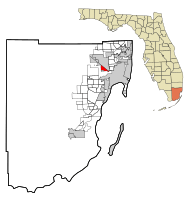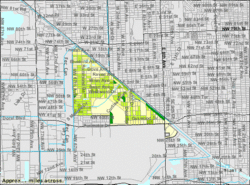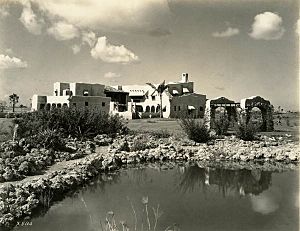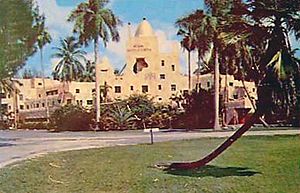Miami Springs, Florida facts for kids
Quick facts for kids
Miami Springs, Florida
|
||
|---|---|---|
| City of Miami Springs | ||
|
||
| Motto(s):
At the Heart of it All!
|
||

Location in Miami-Dade County and the state of Florida
|
||

U.S. Census Bureau map showing city limits
|
||
| Country | ||
| State | ||
| County | ||
| Incorporated | August 23, 1926 | |
| Government | ||
| • Type | Council-Manager | |
| Area | ||
| • Total | 2.98 sq mi (7.73 km2) | |
| • Land | 2.88 sq mi (7.46 km2) | |
| • Water | 0.11 sq mi (0.27 km2) | |
| Elevation | 6 ft (2 m) | |
| Population
(2020)
|
||
| • Total | 13,859 | |
| • Density | 4,813.82/sq mi (1,858.78/km2) | |
| Time zone | UTC-5 (EST) | |
| • Summer (DST) | UTC-4 (EDT) | |
| ZIP codes |
33166, 33142 (Miami)
|
|
| Area code(s) | 305, 786, 645 | |
| FIPS code | 12-45200 | |
| GNIS feature ID | 0286762 | |
Miami Springs is a city in Miami-Dade County, Florida, United States. It's part of the larger Miami metropolitan area in South Florida. In 2020, about 13,859 people lived here.
Contents
History of Miami Springs
Miami Springs was founded by Glenn Hammond Curtiss, known as "The Father of Naval Aviation." He worked with James Bright during Florida's big "land boom" in the 1920s. The city was first called "Country Club Estates."
Miami Springs was one of Florida's first planned communities. This means it was carefully designed before people moved in. The city had a special theme: a unique architectural style called Pueblo Revival. This style comes from the American Southwest, especially New Mexico. It looks like traditional pueblo villages. Some buildings also used Mission-style designs. The original Hotel Country Club was even built to look like a pueblo village!
Just before it officially became a city in 1926, its name changed to Miami Springs. This new name came from a natural spring in the area. This spring provided fresh water to parts of Miami until the mid-1990s.
Aviation and the City's Growth
Because Glenn Curtiss was an aviation pioneer, Miami Springs has always been connected to the airline industry. The Miami International Airport (MIA) is located just south of the city. Many people who worked for airlines lived in Miami Springs. This brought a lot of success to the city.
However, this strong link to aviation also made the city vulnerable. In 1991, two major airlines, Eastern Airlines and Pan American World Airways, suddenly closed down. Many Miami Springs residents lost their jobs. This also affected local businesses, causing many to close.
Even with these challenges, Miami Springs has remained a strong community. It's often seen as a calm and stable place within Miami-Dade County. This helps new residents move in and keep the community lively.
Geography of Miami Springs
Miami Springs is located northwest of downtown Miami. It shares borders with the city of Hialeah to the northeast. To the southwest, it borders the village of Virginia Gardens.
U.S. Route 27 runs along the border between Miami Springs and Hialeah. This road goes east to Wynwood, Miami and northwest to Hialeah Gardens. To the south, Miami Springs is next to Miami International Airport.
The United States Census Bureau says Miami Springs covers about 3 square miles (7.7 square kilometers). Most of this area is land, about 2.9 square miles (7.5 square kilometers). A small part, about 0.1 square miles (0.27 square kilometers), is water.
The main part of Miami Springs looks like a triangle. Its southern edge is mostly Northwest 36th Street. The Miami River canal forms its northern and eastern border. The Ludlam Canal and the Florida East Coast Railroad Yard mark its western side.
Neighboring Areas
- Hialeah
- Medley
- Miami
- Unincorporated Miami-Dade County
- Virginia Gardens
- Miami International Airport
Population and People
| Historical population | |||
|---|---|---|---|
| Census | Pop. | %± | |
| 1930 | 402 | — | |
| 1940 | 898 | 123.4% | |
| 1950 | 5,108 | 468.8% | |
| 1960 | 11,229 | 119.8% | |
| 1970 | 13,279 | 18.3% | |
| 1980 | 12,350 | −7.0% | |
| 1990 | 13,268 | 7.4% | |
| 2000 | 13,712 | 3.3% | |
| 2010 | 13,809 | 0.7% | |
| 2020 | 13,859 | 0.4% | |
| U.S. Decennial Census | |||
2020 Population Details
In 2020, the city had 13,859 people living in 5,245 households. About 3,204 of these were families.
Most people in Miami Springs are of Hispanic or Latino background, making up about 78.58% of the population. The next largest group is White (not Hispanic), at about 18.23%. Other groups like Black or African American, Asian, and people of two or more races make up smaller percentages.
Economy
The Consulate-General of Bolivia in Miami is located in Miami Springs. This is like an embassy for Bolivia in the city.
Important Historical Places
Curtiss Mansion
The Curtiss Mansion is a home built in the Pueblo style. It used to belong to the city's founder, Glenn Curtiss. Sadly, starting in the late 1970s, the house was damaged by vandals and fires.
Fair Haven Nursing Home
Fair Haven Nursing Home is one of the oldest buildings in Miami Springs. It's also built in the pueblo style, which was popular when the city was first developed. The building was designed by architect Bernard E. Muller. It was named a Miami Springs Historic Site in 1984.
This building was originally the Hotel Country Club, built by Glenn Curtiss and his partners. It was meant to help develop the new Country Club Estates. Inside, it had a Southwestern feel, with Navajo rugs and handmade mahogany furniture.
After a financial crash in 1929, Curtiss sold the hotel to his friend John Harvey Kellogg. Kellogg renamed it the "Miami Battle Creek Sanitarium" and ran it for many years. During World War II, it was used as a hospital for military personnel. Later, it became a home for the elderly, which it still is today.
You can take a "Virtual Tour of Historic Miami Springs" on the city's website: [1]
Education in Miami Springs
Miami Springs has many public and private schools.
The city's public schools are part of the Miami-Dade County Public Schools System (M-DCPS). They follow rules set by the Florida Department of Education. Public schools serving Miami Springs include:
- Miami Springs Senior High School
- Miami Springs Middle School
- Miami Springs Elementary School
- Springview Elementary School
There are also two charter schools in Miami Springs:
- Glenn Curtiss Elementary AIE Charter School (Academy for International Education) teaches students from kindergarten to 8th grade.
- ISAAC Academy (Integrated Science and Asian Culture) also teaches students from kindergarten to 8th grade.
Private schools in Miami Springs are mostly run by local religious groups:
- All Angels Episcopal Church has All Angels Academy.
- Blessed Trinity Catholic School, part of the Roman Catholic Archdiocese of Miami, is in nearby Virginia Gardens. It teaches students from kindergarten to 8th grade.
- Grace Lutheran Church runs Grace Lutheran Learning Center.
Images for kids
See also
 In Spanish: Miami Springs para niños
In Spanish: Miami Springs para niños







